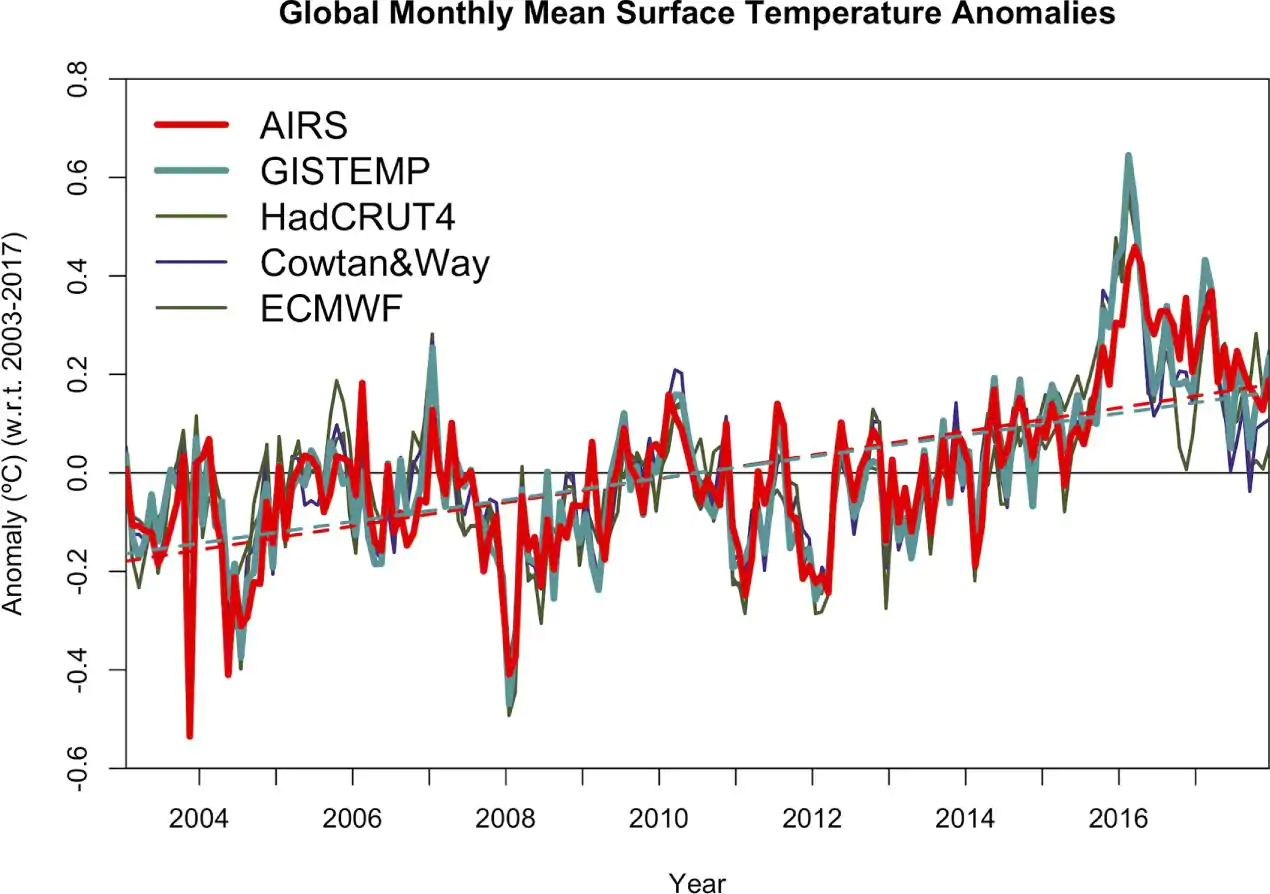Satellite confirms key NASA temperature data: The planet is warming — and fast.

New evidence suggests one of the most important climate change data sets is getting the right answer.
A high-profile NASA temperature data set, which has pronounced the last five years the hottest on record and the globe a full degree Celsius warmer than in the late 1800s, has found new backing from independent satellite records — suggesting the findings are on a sound footing, scientistsreported Tuesday.
If anything, the researchers found, the pace of climate change could be somewhat more severe than previously acknowledged, at least in the fastest warming part of the world — its highest latitudes.
“We may actually have been underestimating how much warmer [the Arctic’s] been getting,” said Gavin Schmidt, who directs NASA’s Goddard Institute for Space Studies, which keeps the temperature data, and who was a co-author of the new study released in Environmental Research Letters.
NASA’s flagship data set, known as GISTEMP, is one of two kept by agencies of the U.S. government, the other being maintained by the National Oceanic and Atmospheric Administration. Both data sets — along with several others maintained by institutions and academic groups around the world — are based on a merger of the records of thousands of thermometers spread across Earth’s land surfaces, and a growing volume of ocean measurements from buoys and other instruments.
Watch video here
As the data sets have shown not only steady global warming also but a string of new temperature records, they have come under increased scrutiny, with occasional criticism of the high-profile findings and how they are stitched together. However, the research groups have maintained that their methods are valid and that the different records agree considerably more than they disagree, suggesting that the warming trend they are showing is, more or less, correct.
Enter NASA’s Aqua satellite, which has been in orbit since 2002, and carries an infrared device that is able to independently measure temperatures at the surface of Earth and, in fact, do so with a higher degree of resolution than characterizes the NASA climate data set.
The temperature record provided by the satellite, which runs from 2003 through 2018 at present, supports NASA’s finding that 2016 was the hottest year on record and, generally, that the warming trend continues just as the surface thermometers have claimed, finds the study led by NASA’s Joel Susskind.
“What you end up with is a really impressive correspondence between the trends that you’re seeing in this satellite product, which is totally independent of the surface temperatures, and the interpretations of the weather stations,” said Schmidt, one of Susskind’s three co-authors.
Here is a figure from the study showing how closely NASA’s data set from the years 2003 through 2017 matches the findings of the Atmospheric Infra-Red Sounder on the Aqua satellite, or AIRS — and how those in turn track three other global temperature data sets:

“What you end up with is a really impressive correspondence between the trends that you’re seeing in this satellite product, which is totally independent of the surface temperatures, and the interpretations of the weather stations,” said Schmidt, one of Susskind’s three co-authors.
Here is a figure from the study showing how closely NASA’s data set from the years 2003 through 2017 matches the findings of the Atmospheric Infra-Red Sounder on the Aqua satellite, or AIRS — and how those in turn track three other global temperature data sets:
Notably, AIRS sometimes shows more warming than the NASA data set, and especially does so in the Arctic, a region where measurements are scarce and warming is fastest. Shockingly, it even finds that over the Barents and Kara seas in the Arctic, the warming trend is at a rate of 2.5 degrees Celsius — or 4.5 degrees Fahrenheit — per decade.
This suggests that, if anything, Earth as a whole may be warming faster than NASA has until now claimed — not more slowly.
“These findings should help put to rest any lingering concerns that modern warming is somehow due to the location of sensors in urban heat islands or other measurement errors at the surface,” said Zeke Hausfather, a researcher at the University of California at Berkeley who works on another of the temperature data sets — called Berkeley Earth — and commented on the new study, with which he was not involved.
“The AIRS satellite data captures the whole surface of the planet and shows that, if anything, our surface measurements are slightly underestimating the rate of modern warming,” he said.
The study also reinforces "that the Arctic is warming much faster than the rest of the world, and that correctly estimating temperatures in the region is important to understanding what is happening to the world as a whole,” Hausfather said.
The new research “confirms (yet again) from an independent source that the surface temperature records over the past couple of decades are robust,” added Ed Hawkins, a climate researcher at the University of Reading in Britain, by email.
The methodologies used to calculate Earth’s temperature are being improved all the time — and the data sets are constantly updated with the most recent information. Lively debates will persist about how to deal with some of the problems involved in this process, such as that cities tend to be warmer than the countryside, and that records are far more numerous and reliable today than they were at the close of the 19th century or a little bit before it, when the data sets begin.
But the new study suggests none of this weakens the major conclusion: Warming is ongoing; and Earth keeps pushing record temperature highs, at least in the context of the past 140 years or so.
“For all the issues that there are, the patterns are not just qualitatively right, they’re pretty much quantitatively right, too,” Schmidt said.
17 April 209



